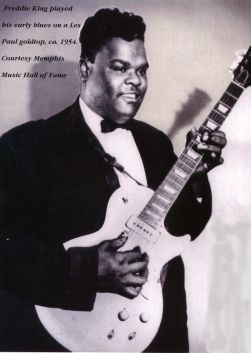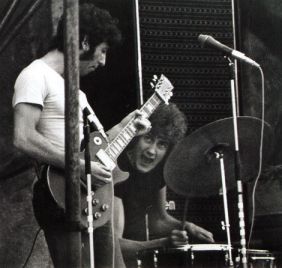Clapton's Bluesbreakers 1960
Gibson Les Paul Standard Guitar
by DeltaNick
Speculation abounds concerning the vintage
of Eric Clapton's Gibson Les Paul Standard guitar that he used in 1965-1966 while with
John Mayall & The Bluesbreakers. It is well known that Clapton's replacement in
Mayall's band, Peter Green, used a 1959 model Les Paul Standard. Not so well known is that
Green's replacement, Mick Taylor, used a 1958 model Les Paul guitar. However, the vintage
of Clapton's famous guitar -- the one he used to record Blues Breakers With Eric
Clapton -- has never been known. I believe that Clapton himself probably didn't
know the vintage of his favorite Les Paul guitar.

1960 Les Paul Cherry Sunburst
(from the Gruhn Guitar collection)
|
Gibson introduced the Les Paul model
guitar in 1952. In order to increase lackluster sales in the period 1958-1960, the Les
Paul Standard model was introduced in a cherry sunburst finish only. Some 1700 or so of
these 1958-1960 guitars were manufactured. Yet, there are even some differences between
the Les Paul Standard models of 1958-1960: the '58 had thinner frets than the '59 and '60;
the red portion of the cherry sunburst on '58s and '59s faded somewhat in comparison to
that of the '60; the '60 was given double-ring Kluson tuners; the '60 truss rod cover had
the words "Les Paul Standard," a change from previous years; and finally,
"the 'extra slim, fast, low-action neck' introduced as a standard feature of all
Gibson guitars at the beginning of 1960."
The Les Paul as we know it was discontinued after the 1960
model year. However, sometime around June 1965, Clapton purchased a 1958, 1959, or 1960
Gibson Les Paul Standard guitar, slightly used, in Lew Davis' shop, Charing Cross Road,
London (Harry Shapiro, "The Wall Of Sound," MOJO, April 1998, p. 91).
This is the guitar that Clapton used while with John Mayall & The Bluesbreakers,
recording the John Mayall, Blues Breakers With Eric Clapton (aka Beano)
album with it. In fact, it is pictured on the back of the album. Clapton began a trend,
and the Gibson Les Paul guitar--and in particular, the Standard 1958, 1959, and 1960
models--became the very first "vintage" electric guitar sought by guitarists and
collectors. Today, 1960 vintage models sell for the most, followed by the 1959, and then
the 1958. The value of all other vintage Les Paul guitars--and model years--pales in
comparison. And today, 1958-1960 Les Paul Standard guitars command extremely high prices,
sometimes bringing their owners $50,000 and more. In 1968, owing largely to Clapton's
popularizing of the model, Gibson reintroduced the Les Paul and it remains the
manufacturer's best-selling line of guitars. |
| So what else is known about this particular
Les Paul guitar that Clapton owned and used while in the Bluesbreakers? Photographs reveal
that Clapton removed the two chrome-plated pickup covers from the guitar. In 1998,
DERAM/PolyGram reissued a remastered, 24-track (both mono and stereo) version of Beano
on CD (available in Europe only). The remastered CD includes additional photographs from
the original 1966 recording sessions. These previously unpublished photographs reveal that
the pickups on Clapton's guitar were of different colors: the bridge pickup was black and
the neck pickup cream-colored. Sometime around June or July 1966, during early Cream
rehearsals and before Cream's first gig (29 July 1966 at the Twisted Wheel in Manchester,
England), the guitar was stolen. Over the years, Clapton remarked in interviews that he
still misses this particular guitar. |

|
This was the only electric guitar
that Clapton was known to use during the yearlong period that he was its owner. Later
photographs of Clapton reveal that he continued to use Gibson Les Paul Standard guitars
for several months and the Standard and other Les Paul models (Custom, Les Paul
"SG") for several years. Clapton played a Les Paul Standard with a Bigsby
tremolo and beautiful figured maple "flametop," for example, at Cream's official
"debut" (31 July 1966 at the 6th National Jazz & Blues Festival in Windsor,
England). Later Cream photographs, taken prior to the band's--and Clapton's--first US
visit in March-April 1967, show Clapton with yet a third Gibson Les Paul Standard guitar.
This guitar was missing its cream-colored pickup switch cover and didn't appear to be a
figured maple "flametop." And another photograph of a 1968 Cream soundcheck in
Anaheim, California, shows Clapton with a sunburst Gibson Les Paul Standard guitar,
although it's not clear whether this is the "third" or yet another guitar.
In later years, Clapton played still other Gibson Les
Paul--Standard, Custom, and other model--guitars. However, my only concern here is the
particular guitar that Clapton used while a member of the Bluesbreakers. And I believe
that a reading of the following four interview excerpts (with Clapton; Clapton's guitar
technician Lee Dickson; and Peter Green, particularly concerning his and Clapton's guitar
necks) leads to the self-revealing conclusion that Clapton's Bluesbreakers guitar was a
Gibson Les Paul Standard 1960 model guitar.
 |
Interview excerpt #1: "Out From Behind The Sun: (13 April 1985) Eric Clapton
Interview By Dan Forte," Best Of Guitar Player: Clapton, 1992, pp. 64-78.
"The 'best' Les Paul I ever had was stolen
during rehearsals for Cream's first gig. It was the one I had with John Mayall, just a
regular sunburst Les Paul that I bought in one of the shops in London right after I'd seen
Freddie King's album cover of Let's Hide Away And Dance Away, where he's playing a
gold-top. It had humbuckers and was almost brand new--original case with that lovely
purple velvet lining. Just magnificent. I never really found one as good as that. I do
miss that one." |
Interview excerpt #2:
"A Tribute To Slowhand: Clapton, (1985)
Interview By Dan Forte" Guitar World, December 1989 (Volume 10, Number 12),
pp. 32-61, 79-80.
Guitar World: Is
the Bluesbreakers-period Les Paul the one that was stolen?
[Eric] Clapton: Yes, that one was stolen
during rehearsals for Cream.
GW: So you didn't use it on Fresh
Cream?
Clapton: No, I borrowed a guitar for
that; it was a borrowed Les Paul. I went through quite a few and until about five years
ago never got one that was anywhere near the original one in terms of the neck shape and
fingerboard.
GW: Both Bluesbreakers and Fresh
Cream have such classic Les Paul tones. They were both played through Marshall amps;
were they different types of Marshalls?
Clapton: Yeah, I think on Fresh Cream
we had a bigger, 100-watt [1959 Superlead, as opposed to the 50-watt 1962 combo].
GW: Did you know that Marshall has
reissued the 1962 combo as the "Bluesbreaker"?
Clapton: Did they really? How sweet. I
didn't even know that. How does it sound? You know, that'd be good because I'm always
looking for something to replace this Fender tweed [Twin]. You can't take it on the road;
it's pretty unreliable. So to have something of that strength that would be reliable would
be worth looking into.
(later in the interview)
GW: Do you currently own a Les Paul?
Clapton: Yes, a very, very good one
that's almost identical to the one that was stolen.
(later in the interview)
GW: To get the so-called "woman
tone" on Disraeli Gears were you still playing through the same setup--the
SG/Les Paul and Marshall stack -- with the guitar's one backed off??
Clapton: With the tone backed off on the
neck pickup.
GW: Backed off how much?
Clapton: All the way, and full volume.
Interview excerpt #3:
"Clapton Sells Out! Would You Buy A Used
Guitar From This Man?" Guitarist (UK), June 1999 (Issue 182), pp. 62-91,
including comments by Eric Clapton's guitar technician, Lee Dickson.
Lee [Dickson]: I
first picked up on Eric in John Mayall's Bluesbreakers, when he was using the Les Paul
Standard. He has a beautiful 1960 Les Paul which he's decided to keep, as he still uses it
a lot and has owned it since way before my time. But he's put the remaining Les Pauls,
which are varied, into the sale. There's a Les Paul Recording, which was a gift from Les
Paul himself and is actually signed to Eric from Les, so that's pretty special. And
there's a really nice cherry wine coloured one, which Eric found a wee bit too heavy.
There's also a lovely '59 Reissue which is also a beautiful piece.
Interview excerpt #4:
| Interview with Peter Green, Guitarist
(UK), September 1999 (Issue 185), pp. 74-78.
Fleetwood Mac
Debut performance at
Windsor Blues Festival
13th Aug 1967
(Peter Green & Mick Fleetwood) |
 |
 |
Guitarist [referring
to Clapton while with the Yardbirds]: Clapton didn't impress you much at first
then? Peter Green: Well, I wasn't a
lead guitarist then, I played bass. Anyway, he was the other side of the stage so I
couldn't hear it too well. It was all very good, though, very exciting. And I decided to
go back on lead guitar after seeing Eric Clapton. I'd seen him with the Bluesbreakers
before he considered singing and his whole concentration was on his guitar--he had a
Telecaster--and it was really impressive. Then he had a Les Paul and his fingers were
marvelous. It took everything away from me, like my birthday, Christmas; you forgot
everything, just listen to this. All music that you'd ever heard was washed away by this
group of guys that were letting Eric Clapton take the floor.
I loved Les Paul and Mary Ford and I was surprised to see
this guitar turned over to this style, but once it got there it was just ... you couldn't
compare it to anything. This guy knew how to do a bit of evil, I guess.
Guitarist: So you had to go and buy one?
Green: I stumbled across one when I was
looking for something more powerful than my Harmony Meteor. I went into Selmer's in
Charing Cross Road and tried one. It was only 110 pounds [price, not weight] and it
sounded lovely and the colour was really good. But the neck was like a tree trunk--like
the tree trunk was spliced down the middle and half of it was used for your guitar neck!
It was very different from Eric's, which was slim: very fast action. I've never seen
another guitar with such an old-fashioned neck. But I couldn't consider the Telecaster for
some reason and I didn't want a Stratocaster.
Y'know Eric's Les Paul would go for fifty million now. It
was a special one. Mine was a funny old fuddy-duddy, sweet old thing. If I had my time
again I wouldn't sell my Harmony Meteor, I'd progress on that because the sound was so
lovely at the Mayall audition. I use a Fender Strat now and a Gibson Howard Roberts Fusion
model, but I'm thinking of getting a Gretsch Roc-Jet as well--the Roc-Jet is a lovely old
thing. |
NOTE: The following book was consulted
for information regarding Gibson guitars: Gibson Electrics: The Classic Years - An
Illustrated History From The Mid-'30s To The Mid-'60s, A.R. Duchossoir, ISBN: 0793592100,
Hal Leonard Corporation, Milwaukee, Wisconsin, 1994, Revised 1998. Chapters regarding
the development of Humbucking pickups (pp. 62-68), solid body guitars (pp. 84-92), and an
annex of Les Paul Standard guitar specifications and production numbers (pp. 207-210) were
most helpful.
© DeltaNick
& Graeme Pattingale, 1999



